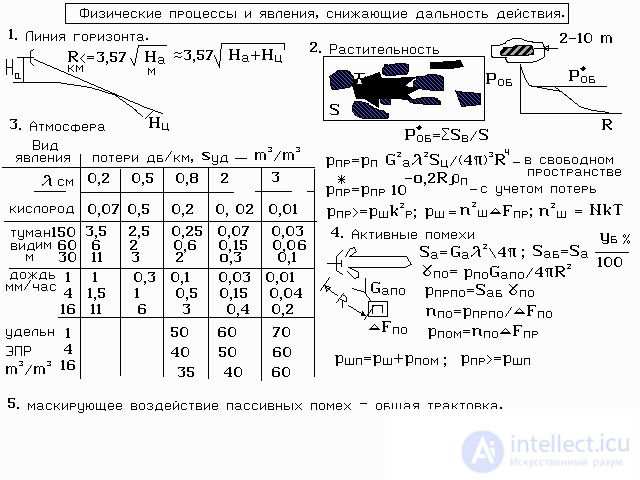Oxygen, water vapor, dust have a tangible effect. Meteo precipitations provide not only direct attenuation of radio waves, but can also create strong reflections, shielding, or suppressing signals from targets. In addition, ground targets are shielded by topography and vegetation.

The distance to the horizon line is determined by the height of the target H c and the height of the rise of the radar antenna - h a . This is shown on form (1).
To assess the impact of vegetation formations on the probability of detecting a ground target, it is necessary to know the total area, for example, of forests S l and the total area viewed by the radar space S. Then, if we assume that the position of the target on the area S is equiprobable, the probability of its detection from the first survey of the space P о * can be calculated as the geometric probability, taking the area ratio of visible areas s in to total area s . This is illustrated in clause 2 of the poster.
The effect of atmospheric oxygen, fog and rain is determined by the attenuation per kilometer of radio waves in decibels per kilometer. Knowing the maximum range of the radar is easy to calculate the attenuation value for each range of radio waves.
To calculate the level of interference from rain, it is necessary to know its EPR - specific effective scattering surface g (3) [m 3 / m 3 ] on the scale meter cubed per meter cubed. By calculating the actual allowable volume of a specific radar at a given range of V [m 3 ] and multiplying it by the specific ESR, you can get the ESR of the rain in the allowable volume - s d .
s = v g (3)
Various active intentional interference is used to suppress radar. The most effective are broadband , noise. It is not superfluous to recall that the action of the radar is ensured by a given ratio of the signal level, p apr , to the noise level of the receiver p w . Active noise interference dramatically increases the noise level, which leads to a sharp decrease in the range of the radar, and as a result - to the failure to perform the tasks. At position 4 of the poster, the equation for the effect of active interference is derived. The conclusion is based on the calculation of the interference power at the input of the radar antenna. It is believed that the radar can always be suppressed by the main lobe. Therefore, the calculation is carried out on the side lobes of the DND, which have a known average level in percent relative to the main one. To understand the logic of the derivation of the equation, it is advisable to recall the derivation of the radar equation. There are the same designations.


Comments
To leave a comment
Radio Engineering Systems
Terms: Radio Engineering Systems